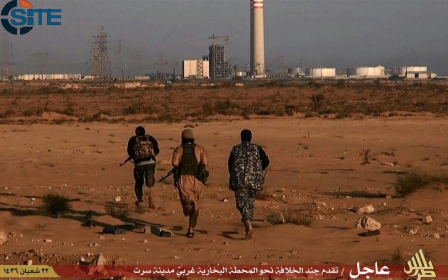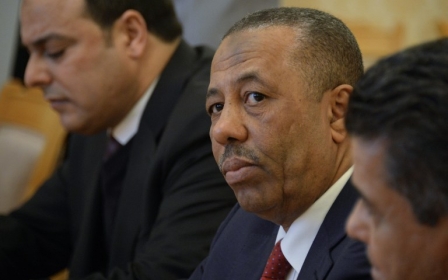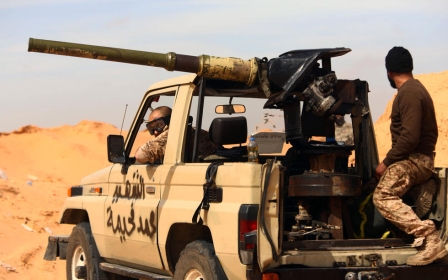Islamic State brutally crushes Sirte uprising

The Islamic State group has mercilessly crushed a two-day uprising in the Libyan town of Sirte, which has been under its control since July, leaving at least 40 people dead, local sources told Middle East Eye.
District Three of Sirte - in the west of the town - had quietly resisted full IS control since militants took over, but the killing of a prominent Salafi-orientated imam from the area on 10 August appears to have sparked the uprising, which was led by members of the Ferjani tribe - the largest tribe in the town - and its local Battalion 136.
“IS surrounded District Three, which is full of ordinary civilians, including elderly people, women and children,” said a senior local figure in the town.
“There were injured people, literally dying in the streets, but no one could get in or out of the area to help them. We know that at least 40 people have been killed in the fighting, but we fear there are many more dead in District Three that we do not yet know about.”
Another resident described how two days of violence culminated in the uprising being crushed by excessive force, as IS militants surrounded the area and opened fire.
“IS entered the outskirts of District Three with tanks, shelling residential buildings with missiles, mortars and other heavy weaponry,” he said, not wanting to give his name for safety reasons. “They set fire to a medical centre with 22 injured people inside and they were burned alive. Really, this was a massacre.”
The information could not be independently verified but three people killed in the clashes have since been named on social media as the commander of Battalion 136, Ali Saadak, and two of his sons, Abubasit Ali and Mourad Ali.
Their family home was reportedly then burned to the ground, a strategy IS has been employing in the town since Ramadan, when it razed the homes of 12 families accused of supporting the city of Misrata, allied with the Tripoli government, local sources told MEE.
A senior member of the local group of civil society organisations was reportedly captured and killed after rescuing a tribal elder who had been injured in the cross-fire and taking him to the town’s Ibn Sina hospital.
“He was a civilian and an innocent man who spent four years working on humanitarian issues and local reconciliation,” said his friend, Ahmed, via telephone. “He was a well-respected local man, and he was killed only because he was from the Ferjani tribe.”
On Friday, what appeared to be the final stages of a bloody 48 hours was being played out in the town, with IS militants reportedly hunting down and executing members of the Ferjani tribe to set a public example and prevent further dissent.
One man who returned to Sirte on Thursday night spoke to MEE on the telephone in hushed tones from the house where he was in hiding. “We have been warned that any of us from the Ferjani tribe found on the streets of Sirte will be executed,” he said. “My relatives told me not to come last night, but my family is here, and I had to be with them.”
Uprising begins
According to local sources, the unrest began on 11 August after the murder of Salafi Imam Khalid bin Rajab Ferjani. A prominent member of the Ferjani tribe, he had preached against IS the preceding Friday, criticising the militants for putting increased pressure on anyone in the local community, who had served in the military or police, to sign repentance documents. Ferjani went as far as to urge residents not to sign the papers, sparking fierce retribution from IS.
“He said that repenting in front of IS was prohibited by Islam and he said that IS did not represent real Muslims and [that they] were corrupting the Islamic faith,” local resident Mohamed said.
As tensions mounted in District Three, where the imam had lived, IS leaders sent a message to the Ferjani tribe, via a mediator, telling them that there was no state to protect them and that if they did not hand over their weapons they would be massacred.
“Local people really believed support would come, but IS somehow knew that it wouldn’t,” he said.
Sirte’s IS members were quick to bring reinforcements from the several-hundred kilometre stretch they now control along the central Libyan coast to crush the uprising, with more than 100 military vehicles arriving from the east and south of Sirte, local sources told MEE.
Neither of Libya’s rival governments sent any military support to help the people of Sirte. Despite the Tripoli government announcing the start of a military offensive to free Sirte from the clutches of IS on 11 August, only one brigade set out from the city of Misrata on Thursday morning.
When it arrived at the last checkpoint on the edge of IS-controlled territory, it found that promised reinforcements were not there and turned back. Previous attempts by troops loyal to Tripoli to liberate Sirte had also failed when support in the form of personnel and weapons did not materialise.
While Sirte staged its uprising alone, a large military parade took place in the centre of Tripoli, celebrating the 75th anniversary of the founding of the Libyan Army. The event was widely condemned on social media as a national moment of shame.
“While ordinary civilians, including some women - one of whom was killed - fought against IS in the streets of Sirte, hundreds of trained soldiers were marching in Tripoli. This is really shameful,” said local resident Ahmed. “Sirte is becoming like the IS capital of Libya and, when the people rose up against it, no-one came to help.”
The Tripoli-based news agency LANA reported on Friday afternoon that the Tripoli government’s air force had started carrying out air attacks on the town. But, as Ahmed pointed out, for many residents this was too little, too late.
“Sirte is becoming like the IS capital of Libya and, when the people rose up against it, no-one came to help,” Ahmed said.
Middle East Eye propose une couverture et une analyse indépendantes et incomparables du Moyen-Orient, de l’Afrique du Nord et d’autres régions du monde. Pour en savoir plus sur la reprise de ce contenu et les frais qui s’appliquent, veuillez remplir ce formulaire [en anglais]. Pour en savoir plus sur MEE, cliquez ici [en anglais].




